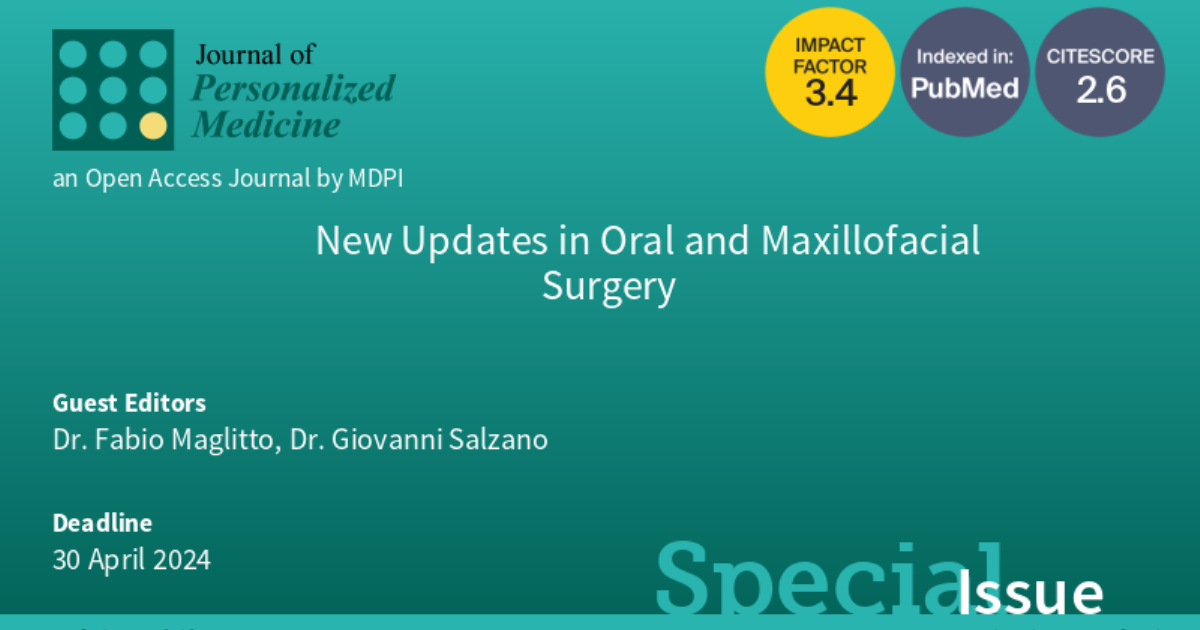New Updates in Oral and Maxillofacial Surgery
A special issue of Journal of Personalized Medicine (ISSN 2075-4426). This special issue belongs to the section "Methodology, Drug and Device Discovery".
Deadline for manuscript submissions: closed (30 April 2024) | Viewed by 8224

Special Issue Editors
Interests: oral and maxillofacial surgery; plastic surgery; otolaryngology
Interests: oral and maxillofacial surgery; plastic surgery; otolaryngology
Special Issues, Collections and Topics in MDPI journals
Special Issue Information
Dear Colleagues,
In recent years, with the rapid development of medical equipment, surgical techniques, and biomaterials, the field of oral and maxillofacial surgery is switching to digital and personalized treatments. This includes digital imaging, digital impressions, jaw modeling, 3D planning of complex oral prosthetics, osteophytes and implant placement, and minimally invasive surgery, such as endoscopic and functional surgery.
This Special Issue, entitled "New Updates in Oral and Maxillofacial Surgery", aims to discuss personalized treatment and future trends in oral and maxillofacial surgery. Therefore, we encourage researchers (clinicians and scientists) in the fields of plastic surgery, oral and maxillofacial surgery, otolaryngology–head and neck surgery, and neurosurgery to submit original articles or reviews to this Special Issue of Journal of Personalized Medicine.
Topics may include (but are not limited to):
- Orthognathic surgery, surgical treatment/correction of dental and maxillofacial malformations;
- Head and neck cosmetic surgery;
- Oral cancer;
- Reconstructive surgery;
- Management of oral diseases;
- New methods and techniques in oral and maxillofacial surgery;
- Oral and maxillofacial soft and hard tissue trauma and reconstruction techniques;
- Drug-related osteonecrosis of the jaw;
- New diagnostic and therapeutic tools for the management of potentially malignant diseases of the oral cavity;
- Temporomandibular joint (TMJ) disorders.
Dr. Fabio Maglitto
Dr. Giovanni Salzano
Guest Editors
Manuscript Submission Information
Manuscripts should be submitted online at www.mdpi.com by registering and logging in to this website. Once you are registered, click here to go to the submission form. Manuscripts can be submitted until the deadline. All submissions that pass pre-check are peer-reviewed. Accepted papers will be published continuously in the journal (as soon as accepted) and will be listed together on the special issue website. Research articles, review articles as well as short communications are invited. For planned papers, a title and short abstract (about 100 words) can be sent to the Editorial Office for announcement on this website.
Submitted manuscripts should not have been published previously, nor be under consideration for publication elsewhere (except conference proceedings papers). All manuscripts are thoroughly refereed through a single-blind peer-review process. A guide for authors and other relevant information for submission of manuscripts is available on the Instructions for Authors page. Journal of Personalized Medicine is an international peer-reviewed open access monthly journal published by MDPI.
Please visit the Instructions for Authors page before submitting a manuscript. The Article Processing Charge (APC) for publication in this open access journal is 2600 CHF (Swiss Francs). Submitted papers should be well formatted and use good English. Authors may use MDPI's English editing service prior to publication or during author revisions.
Keywords
- oral and maxillofacial surgery
- digital planning
- head and neck surgery
- reconstructive surgery
- implant–prosthetic rehabilitation
- oral diseases
- regenerative dentistry







